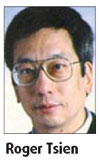Two Americans, one of Chinese origin, and a Japanese scientist won the Nobel Prize in chemistry yesterday for discovering and developing a glowing jellyfish protein that revolutionized the ability to study disease and normal development in living organisms.

Americans Roger Tsien and Martin Chalfie, as well as Japan's Osamu Shimomura shared the prize for their work on green fluorescent protein (GFP), the Royal Swedish Academy of Sciences said.
Researchers worldwide now use GFP to track such processes as the development of brain cells, the growth of tumors and the spread of cancer cells. It has let them study nerve cell damage from Alzheimer's disease and see how insulin-producing beta cells arise in the pancreas of a growing embryo, for example.
The academy compared the impact of GFP on science to the invention of the microscope. For the past decade, the academy said, the protein has been "a guiding star for biochemists, biologists, medical scientists and other researchers".
When exposed to ultraviolet light, the protein glows green. So it can act as a tracer to expose the movements of other, invisible proteins it is attached to as they go about their business. It can also be used to mark particular cells in a tissue and show when and where particular genes turn on and off.
Tsien developed GFP-like proteins that produced a variety of colors so that multiple proteins or cells can be followed simultaneously.
"In one spectacular experiment, researchers succeeded in tagging different nerve cells in the brain of a mouse with a kaleidoscope of colors," the Nobel citation said. The experiment was called the "brainbow".
Shimomura and a colleague found GFP in material they extracted from about 10,000 jellyfish they had recovered off the coast of the US state of Washington. They reported in 1962 that it glowed bright green under ultraviolet light.
Some 30 years later, Chalfie showed that the GFP gene could make individual nerve cells in a tiny worm glow bright green. Tsien later extended the scientific palette to a variety of colors.
"This is a technology that has literally transformed medical research," said Dr John Frangioni, an associate professor of medicine and radiology at Harvard Medical School. "For the first time, scientists could study both genes and proteins in living cells and in living animals."
Tsien, 56, is a professor at the University of California, San Diego.
He is related to Qian Xuesen, the founder of China's space science, who is widely regarded as the "father of the country's aerospace" and "king of rockets".
Zhang Jin, an assistant professor at John Hopkins and a former post-doctor fellow in Tsien's lab, described him as "sagacious". He said Tsien's broad vision has always enlightened and inspired her and other students.
"He likes to try anything new, in academic research, or in his life," she said.
Speaking to reporters by telephone from California, Tsien said he was surprised to receive the award.
"There had been some rumors, but from sources whose reliability was questionable," he said.
In a news release issued by his university, Tsien said he had set his sights on imaging and treating cancer. "I've always wanted to do something clinically relevant in my career, if possible, and cancer is the ultimate challenge," he said.
Shimomura, 80, works at the Marine Biological Laboratory in Woods Hole, Massachusetts, and the Boston University Medical School. Chalfie, 61, is a professor at Columbia University in New York. The trio will split the 10 million kronor ($1.4 million) award.
Gunnar von Heijne, the chairman of the chemistry prize committee, demonstrated the award-winning research to reporters by shining ultraviolet light on a tube with E. coli bacteria containing GFP. The tube glowed in a green fluorescent light.
Von Heijne said that kind of experiment "gets scientists' hearts beating three times faster than normal".
(Agencies via China Daily October 9, 2008)